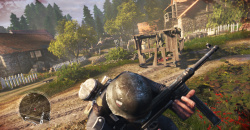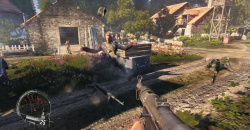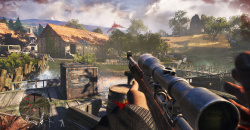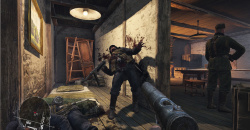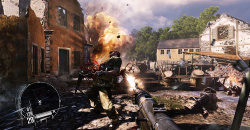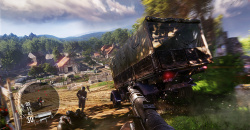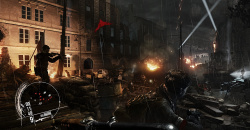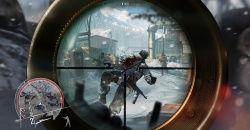After flooding the market for years, the World War II first-person shooter has been put on the video-game industry’s collective backburner. The trend lately has been more towards modern and futuristic settings. But the sharp-shooting specialists at CI Games (Sniper: Ghost Warrior and Alien Rage) are out to prove that there’s still life in the genre, and with Enemy Front, they bring us places we’ve seen very little of in World War II games, like the Warsaw Uprising and the resistance in occupied Norway. Read the test review to find out if it’s as good as it sounds.
Of Reporters and freedom fighters
American war correspondent Robert Hawkins, having had enough with merely writing about events, decides to join the Polish Underground in their struggle against the Nazi occupation of their country. Playable flashbacks reveal that the kidnapping of an important contact is what has led to this sudden career change. He’s fought side by side with resistance groups in Norway, France, and Germany. For Hawkins and his companions, the Warsaw Uprising is a decisive point in their stand against the oppressors.
The ten-hour single-player campaign takes you through several realistic-looking levels punctuated by random flashbacks. Of course, these don’t really do such a good job of explaining how a reporter can become a seasoned warrior in such a short time. Hawkins is apparently a man in high demand, a knight in shining armor who goes from one trouble spot to another, where pale-faced supporting characters seem to just be waiting for him to show up and turn the odds in their favor. No matter how hard they try with all the flashbacks, the plot just isn’t believable. Still, several scenes starkly portray the criminal behavior and human suffering of wartime, such as the arbitrary execution of civilians or severely wounded people in a hospital begging for help.
Shooting, sneaking, sabotage, and some big problems
Run-and-gun mayhem, stealth sequences, and sabotage missions are what’s supposed to make the 16 main missions fun to play. Missions can be played in three different difficulty levels, and objectives include defending or capturing fortified positions, destroying tanks, taking out officers, or sabotaging factories. The game also generates a number of optional side missions – at the beginning of the game, for example, you’ll constantly run across resistance fighters who need your help, and if you manage to get to them before they catch a bullet or two, you’ll be rewarded with not just the good feeling you get from helping a comrade out of a dicey situation, but with weapons and ammo.
In a few places you’ll have to make a decision: do you want to pick off your enemies from an elevated position as a sniper, or do you want to take them out as a grunt with boots on the ground? Do you want to sneak into a building or attempt a frontal assault? Enemy Front really could have used more of these kinds of choices, though. And other decisions seem forced, like when you have to decide which weapon to carry, since you can only carry two guns aside from your pistol. This can be a very important choice, too, since a lot of times you’ll try to avoid a firefight only to get caught in the middle of it anyway.
First and foremost, this game is a shooter. You use pistols, machine guns, shotguns, grenades, Molotov cocktails, or sniper rifles against your enemies, but the enemy AI makes it feel like a shooting gallery – their aim is atrocious, and they make senseless charges right into the resistance fighters’ muzzle flashes. There are enough ammo crates scattered generously about the area that you’ll never want for bullets, and if you do, then there’s probably a gun emplacement nearby, which you can use to great effect, cutting down all your foes without worrying about your losses. You can use your gun sights to more effectively get a bead on your enemies, and another familiar feature is that when you break down doors, a short slow motion sequence allows you to take advantage of the element of surprise.
The zoom and fire buttons use L2 and R2, and since you can’t change the control settings, the controls might feel a bit unusual at first. This shouldn’t really be much of a problem after you play for a little bit, though. A much bigger problem, however, are bugs in the graphics. Constant frame rate interruptions really mess up any sense of immersion in the Warsaw areas, with the graphics often coming off choppy or just plain vague. On top of that, the player character appears to be moving along on tracks instead of realistically walking or running. All these things work together to turn this FPS experience into an almost unplayable mess at times. Accuracy is a bit off as well, which means you’re going to find yourself losing a few firefights you would have otherwise won. Automatic health recovery doesn’t work well, either, which makes it all the more frustrating that checkpoints are poorly placed throughout the levels. In the levels that take place outside of Warsaw, however, these problems are nowhere near as apparent, and everything runs a lot more smoothly. They should release a patch to fix all this as soon as possible.
In many places, it’s to your advantage to proceed with caution, and this requires patience, skill, and excellent timing. There’s a visibility meter to help you out when sneaking, and the mini-map in the lower left corner of the screen is also really useful here. Ideally, you should be able to spot and mark enemies while you’re still some distance away using the binoculars. You can also throw rocks to distract them, or do things like turn off a record player. Light and shadow also play an important role, though not as much as in stealth games like Thief or Splinter Cell, of course. You can sneak up to your target carefully and stealth kill him as quickly and quietly as possible. Of you can use him as a hostage, and see how much his comrades really care about him. Sometimes they’ll ignore you, sometimes they’ll treat you cautiously, and sometimes they’ll just give him up. You can also pick up and drag dead enemies’ bodies, but there’s really no point, as all dead enemies disappear after a short time anyway.
More than anything else, the sniper rifle and a healthy mix of shooting up you enemies and sneaking around are what make Enemy Front an enjoyable experience, especially in the second half of the game. When you look more closely, the areas outside of the strictly linear Warsaw segments turn out to be more than just a way to reach your objectives. Successful long-distance kill shots are honored with the Kill Cam, which follows the path of the bullet in slow motion until it hits its target. There are even situations where you’ll have to be careful not to let disruptive background noises like rockets firing or loud engine noises mess up your aim – or use these loud noises to cover your shots. This is where the developers were able to take advantage of what they learned with Sniper: Ghost Warrior. At its better moments, Enemy Front can really be reminiscent of older, solid sniper games like Project I.G.I.
Multiplayer? Not so much.
I’m afraid I can’t really say much about multiplayer in Enemy Front, since from the time I tested it to shortly before it came out, the servers were blocked. In any case, what I have read about it reads like a bad joke – there are no more than three familiar multiplayer modes like Deathmatch and Team Deathmatch, and just four maps to play them on. The Limited Edition DLC adds more weapons and characters, but this hardly makes it any better.
We are now experiencing technical difficulties…
While the graphics in Enemy Front are based on the tried-and-true CryEngine 3, I wasn’t very impressed with the result in the console versions of the game. And combined with the choppiness in the Warsaw scenes mentioned above, it can have a really negative effect gameplay. Some of the ugly things that stood out were crude faces without any discernable facial expressions, jerky animations, muddled textures, backgrounds that sudden appear out of nowhere, jagged edges, tons of clipping errors, and underwhelming explosions. In addition to this, you constantly run across flickering surfaces and shadows. Graphical strengths include tense night missions in the dark and destructible objects, which you can also use for cover. One thing I was impressed by were the load screens, where the camera skillfully moves through the scene of a heated skirmish frozen in time.
That sniper sound
The sound design in Enemy Front, on the other hand, is somewhat better. Conversations between enemies unaware they’re being watched are pretty entertaining, and the musical score is dynamic, constantly alternating between subdued and grandiose pieces, though sometimes it doesn’t quite fit, especially at the beginning. Chris Velasco, who contributed to God of War and Borderlands 2 among others, has done better work. One final negative are the unimpressive weapons sound effects.










